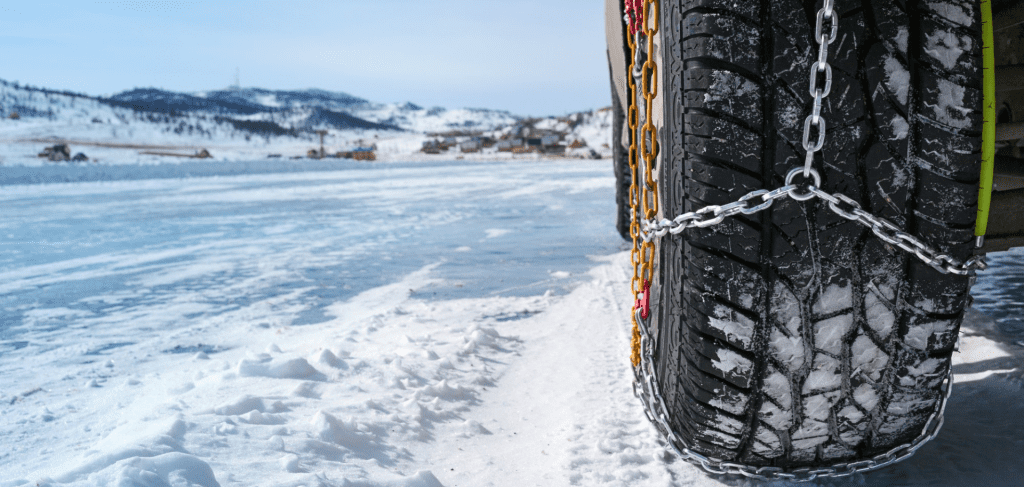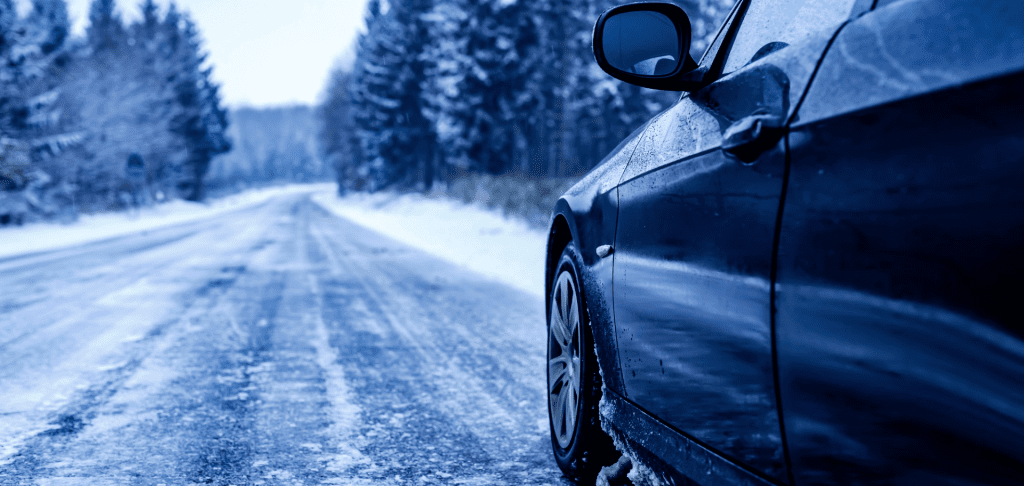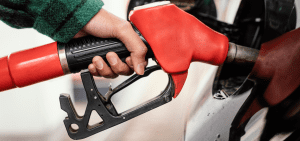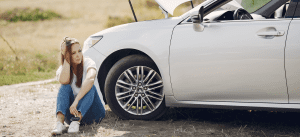Compare cheap breakdown cover
✔ Local, nationwide and European cover options
✔ Compare prices and choose the right policy for you
✔ Cover for cars, vans and motorbikes and scooters


During winter, cars can experience difficulties, and encountering a breakdown in freezing temperatures can be unpleasant and dangerous. Try these cold-weather car maintenance tips to reduce the likelihood of mechanical issues.
Our essential winter driving checklist
Winter weather can make driving challenging and hazardous, with slick surfaces, precipitation, icy vehicle parts, and splashes from nearby vehicles. To ensure your safety during the colder months, we’ve compiled a list of essential winter driving tips and advice.
- Preparing for winter
- A well-maintained battery
- Clean, working lights
- Topped-up oil
- Antifreeze in all the right places
- Good road visibility through your windscreen
- Tyres that can handle cold weather hazards
- Winter driving tips
- Winter driving laws you may not know about
- What to do if you breakdown in winter
- Winter car essentials
- Emergency equipment
- Frequently asked questions
Learn how you can prevent your vehicle from breaking down with our breakdown checklist.
Preparing for winter
Preparing your car for winter is crucial in ensuring your safety and reducing the risk of a breakdown. Although not all breakdowns can be prevented, practicing good car maintenance can significantly minimise the likelihood of one occurring.
By taking a few minutes to perform some essential checks on your vehicle, you can save yourself the trouble and stress of being stranded on the roadside in the cold.
Regular servicing is also important to maintaining your car’s optimal condition. It can help to identify any underlying issues and address them early on, preventing more significant problems from developing in the future.
Despite your best efforts, breakdowns can still happen, especially during the winter months. That’s where breakdown cover becomes invaluable. Having reliable breakdown cover gives you peace of mind, knowing that you have assistance on hand should you encounter any issues on the road.
So, before winter sets in, ensure you have adequate breakdown cover to avoid any unpleasant surprises.
Compare cheap breakdown cover
A well-maintained battery
Maintaining your car battery is crucial during the winter season, as cold and damp weather can significantly impact its performance. According to AXA, cars are 51% more likely to have battery problems during the winter months, with battery issues being the most common cause of breakdown call-outs during this time, according to the AA.
Low temperatures can affect the chemical reactions inside the battery, reducing its efficiency. Additionally, winter months often involve using the lights and heater more, leading to increased battery power consumption. If you’re waiting in your vehicle with the engine off, it’s advisable to limit your use of the heater and stereo to prevent excessive battery drain, which could leave you stranded without enough power to restart the engine.
Car batteries typically last for around five years, with that timeframe potentially reducing to two or three years for those who mainly drive short journeys, according to the AA. If your battery is nearing the end of its working life as winter approaches, it might be worth investing in a new one.
When buying a new battery, the RAC recommends having it professionally fitted. Incorrectly connecting the leads can cause serious damage to your car’s electronic system.
Additionally, old batteries need to be properly recycled, so it’s important to check whether this service is included or to take the old battery to a local recycling centre. By taking these steps, you can ensure that your battery is in optimal condition and ready to handle the challenges of winter driving.
Clean, working lights
Maintaining clean and functional car lights is crucial for your safety while driving in winter. It’s important to ensure that all your car lights are in good working order so that you can see clearly and be seen by other drivers on dark evenings and during rainy or foggy days.
During wintry conditions, dirty spray from the road surface can accumulate on your car lights, causing them to become dim and reducing your visibility. Therefore, it’s essential to regularly clean your car lights thoroughly to maintain optimal visibility.
In addition to cleaning your lights, it’s also advisable to check that they’re properly aligned. Misaligned lights can blind oncoming drivers and reduce your visibility on the road. You can check the alignment yourself or have it done professionally.
How much can you save on European breakdown cover?
Topped-up oil
Monitoring your car’s oil levels is crucial throughout the year, but it’s especially important during the winter season. Cold weather can cause your car’s oil to thicken and become less effective, potentially leading to engine damage and breakdowns.
It’s recommended to check your car’s oil level at least once a month, and more frequently during the winter months. It’s also essential to use the correct oil for your car, as specified in the owner’s manual.
In addition to checking your oil levels, it’s also advisable to check for any oil leaks or signs of damage. Addressing any issues early on can help prevent more significant problems from occurring later.
Breaking down is never a pleasant experience, but it can be particularly uncomfortable and dangerous during the winter season. To avoid the risk of breaking down in the dark and cold, it’s important to keep your oil levels topped up and address any issues promptly.
Antifreeze in all the right places
Ensuring that your car has antifreeze in all the right places is essential for safe winter driving. In addition to keeping your windscreen wash levels topped up, it’s important to make sure that it contains anti-freeze. This will help prevent the solution from freezing and ensure that you can wash your windscreen effectively to maintain optimal visibility.
Some older car models may require additional antifreeze to be added to the radiator to prevent the cooling system from freezing. However, most modern vehicles come pre-filled with longer-lasting antifreeze, which should not be mixed with traditional antifreeze solutions. Mixing different types of antifreeze can cause engine damage and may void your warranty. If you’re unsure about your car’s requirements, it’s advisable to consult a mechanic or refer to your car manual.
It’s worth noting that antifreeze is highly toxic to humans and animals, so it’s important to handle it carefully. Always use gloves and protective gear when handling antifreeze and dispose of it responsibly at a designated waste facility.
By ensuring that your car has the correct type and level of antifreeze, you can help prevent engine damage and ensure that your car is ready to handle the challenges of winter driving.
Good road visibility through your windscreen
Maintaining good road visibility through your windscreen is crucial for safe driving during winter. Although it may be tempting to set off with a partially frozen or steamed-up windscreen when you’re in a hurry, it’s vital to resist the temptation. Reduced visibility can significantly increase your risk of having an accident and being held liable for it.
To ensure optimal visibility, it’s advisable to keep your windscreen wash topped up with a formula containing antifreeze, which will help prevent the solution from freezing. Additionally, it’s essential to make sure that your wiper blades are in good condition. Over time, wiper blades can become worn and ineffective, reducing your visibility and potentially causing scratches on your windscreen.
Replacing wiper blades is a simple and inexpensive process, with many car accessory stores offering a range of options to suit different car models. It’s recommended to replace your wiper blades at least once a year, or more frequently if you notice any signs of damage or reduced effectiveness.
In addition to replacing your wiper blades, it’s also advisable to regularly clean your windscreen both inside and outside to maintain optimal visibility. By taking these steps, you can ensure that your windscreen is in good condition and ready to provide you with clear vision on the road during winter driving.
Compare cheap breakdown cover
Tyres that can handle cold weather hazards
Having tyres that can handle cold weather hazards is essential for safe driving during the winter season. For those living in colder or more rural areas, winter tyres and snow chains can be especially useful for ensuring road safety. Winter tyres have deeper tread patterns, which provide better traction and handling on snow and ice.
If you don’t want to invest in winter tyres or snow chains, it’s still important to make sure that your tyres have enough tread depth. The legal minimum requirement for tread depth is 1.6mm, but the AA recommends a minimum of 2mm, preferably 3mm, for better safety.
This is because wet and wintry conditions increase the risk of aquaplaning, which occurs when water builds up between your tyres and the road surface, leading to a loss of control of the vehicle. The more tread you have on your tyres, the less likely this is to happen.
Along with ensuring adequate tread depth, it’s crucial to regularly check your tyre pressures, conforming to the manufacturer’s recommendations. Properly inflated tyres can improve handling and traction while reducing the risk of a blowout.
Additionally, it’s important to ensure that your spare tyre is in the same good condition as the other four, in case of emergencies.
By taking these steps, you can ensure that your tyres are ready to handle the challenges of winter driving and help keep you safe on the road.


Winter driving tips
Driving in wintry conditions can be challenging, but following these winter driving tips can help you stay safe on the road:
Slow down: This is perhaps the most important tip to remember while driving in the rain, snow, or ice. Braking distances can be significantly extended in these conditions, which means you need to take extra care. To avoid sliding or being unable to stop soon enough, ease off the accelerator and reduce your speed. It’s not worth risking an accident to save a few extra minutes.
Be gentle with the pedals: Avoid accelerating too quickly in the snow, as this can cause wheel spin. Similarly, avoid braking too hard, which can cause you to skid at a higher speed. Gentle, gradual acceleration and braking can help you maintain control of your vehicle on slippery roads.
Avoid tailgating: It’s never a good idea to tailgate, but it’s especially important to give other drivers plenty of space in wet, snowy, or icy conditions. Braking distances can be up to 10 times further than in normal conditions, and less experienced drivers may lose control of their vehicle, becoming a hazard that you’ll want to avoid.
Check your tyres: Before heading out in the rain or snow, check your tyres to ensure that they’re in good condition. This means having the correct pressure and enough tread for grip. If it’s particularly bad, consider using winter tyres or snow chains. Winter tyres have deeper tread patterns, which provide better traction and handling on snow and ice. Snow chains should only be used in thicker snow and can improve traction on steep or slippery roads.
Keep a safe distance: It’s important to maintain a safe distance from other vehicles while driving in wintry conditions. This will give you more time to react if the vehicle in front of you loses control or comes to a sudden stop. The general rule of thumb is to stay at least six seconds behind the vehicle in front of you.
Prepare for emergencies: It’s always a good idea to be prepared for emergencies when driving in winter. Keep an emergency kit in your car, including a blanket, warm clothing, food and water, a first aid kit, and a mobile phone charger. Additionally, make sure that your car is equipped with working lights, a fully charged battery, and enough fuel to make it to your destination.
Compare cheap breakdown cover
Winter driving laws you may not know about
Winter driving can present unique challenges, and it’s important to be aware of any laws or regulations that may apply during the season.
While the rules of the road remain the same throughout the year, harsh weather conditions and reduced visibility require extra caution to stay safe and avoid fines. Here are some winter driving laws that you may not know about.
Download The Highway Code PDFBe cautious when defrosting your car
- Highway code: Rule 123
- Fine: Up to £80
When defrosting your car on a cold morning, it’s important to be cautious and avoid leaving your vehicle unattended while parked in the wrong spot for too long.
Rule 123 of the Highway Code states that drivers must not leave a parked car’s engine running if it’s left unattended or stationary on a public road. Failure to comply can result in a fine of up to £80.
Some local authorities also charge a £20 fixed penalty notice for emission offences and stationary idling, with the potential for the fine to increase to £80. However, these fines are only given out to drivers who refuse to switch off their engines when asked by an authorised person.
It’s important to note that if your car is parked on private land, such as your driveway, leaving the engine running is not an offence. However, unattended idling can increase the risk of car theft, and if your car is broken into or stolen with the keys in the ignition, your insurance claim could be rejected.
So, it’s best to always stay with your vehicle while it’s warming up and defrosting to ensure that it remains safe and secure.
Make sure all windows are clear of snow and ice before you set off
- Highway code: Rule 229
- Fine: £2,500 fine
- Penalty points: Three penalty points
To ensure safe driving in all weather conditions, it’s essential to clear all windows and mirrors of snow and ice, demist them properly, and clean your lights and number plates before setting off. You should also remove any snow from the top of your car to prevent it from falling onto the road or blocking your view from the front or back windscreen.
Not following these rules can result in a fine of up to £2,500 and three penalty points, as stated in rule 229 of the Highway Code.
It’s important to take the time to clear your car of snow and ice properly to ensure that you have good visibility and can operate your vehicle safely. So, don’t forget to follow this rule and take the necessary precautions before driving in icy or snowy conditions.
Avoid on-street parking if it’s foggy, or leave your parking or side lights on
- Highway code: Rules 113 and 251
- Fine: Up to £75
Driving in foggy conditions can be hazardous, and the same goes for parking your car on the road during foggy weather. Whenever possible, it’s best to avoid on-street parking. However, if there are no other options available, it’s important to take necessary precautions to improve visibility and ensure other drivers are aware of your car’s presence.
According to rules 113 and 251 of the Highway Code, drivers should leave their parking or sidelights on when parking at night in foggy conditions. The Road Vehicles Lighting Regulations 1989 also state that drivers must use their headlights while parking at night. Failure to follow these rules can result in a penalty charge notice, with a fine of up to £75. The amount of the fine may vary depending on the region, but it is usually reduced if paid within 14 days.
While not resulting in penalty points on your licence, failing to use your lights can put you and other drivers at risk, so it’s important to follow these rules and take necessary precautions during foggy conditions.
Wear clothing that doesn’t impede your ability to safely drive
- Highway code: Rule 97
- Fine: Up to £2,500
- Penalty points: Three penalty points
As the colder months approach, it’s important to remember that the clothing you wear while driving can have an impact on your ability to operate the vehicle safely. While items like wellies, snow boots, and big winter coats may be cosy and practical for the season, they can also impede your ability to use the vehicle controls or obstruct your view of the road and traffic ahead.
Rule 97 of the Highway Code states that drivers must wear clothing that allows them to maintain proper control of the vehicle and have an unobstructed view of the road. Failure to comply with this rule can result in a fine of up to £1,000 (or £2,500 for PCV or goods vehicles) and three penalty points on your licence. This rule applies to all clothing items, including festive accessories like Santa suits or holiday jumpers, as well as high heels that may be worn to holiday parties.
So, when getting dressed for winter driving, it’s essential to choose clothing that is comfortable but also allows you to operate the vehicle safely and without obstruction. By keeping this in mind and following the rules of the road, you can ensure a safe and enjoyable winter driving experience.
Make sure your seat belt fits around your winter coat
- Highway code: Rule 99
- Fine: Up to £500
Wearing a seat belt or child restraint is a must while driving, and it’s the driver’s responsibility to ensure that their seat belt and the seat belt of any child travelling with them are fitted correctly and not obstructed by thick winter coats.
This is particularly important for babies and small children in car seats, as puffy coats can create more space between the seat belt and the body, which can limit the ability to restrain them in an accident.
According to Rule 99 of the Highway Code, drivers must ensure that their seat belt fits properly and is not obstructed by clothing or any other object. Failure to comply with this rule can result in a fine of up to £500. It’s also important to ensure that children under 14 years old wear seat belts or are in the correct car seat while travelling in a vehicle. Failure to do so can also result in a fine of up to £500.
To ensure safety while driving during the winter months, it’s essential to make sure that you and any passengers are wearing appropriate clothing that does not obstruct the seat belt or child restraint. By following this rule and taking necessary precautions, you can help prevent accidents and ensure a safe driving experience.
Don’t get behind the wheel if you’re too tired
- Highway code: Rule 91
- Fine: Unlimited
- Penalty points: Between three – 11 penalty points
- Imprisonment: Up to two years
Rule 91 of the Highway Code stipulates that drivers should not operate a vehicle when excessively tired. The consequences for violating this rule can be severe and include an unlimited fine, between three and 11 penalty points, and a maximum sentence of two years imprisonment.
The festive season can be an exhausting time, whether you’re rushing to purchase gifts, visiting family and friends, or recovering from a late-night party. However, driving while tired increases the risk of accidents, so it’s crucial to ensure that you’re well-rested before embarking on lengthy journeys.
It’s recommended to take breaks of at least 15 minutes for every two hours of driving and avoid driving between midnight and 6 am, as this is when you may be less alert.
While it may seem obvious, it’s worth noting that you should never start a journey if you don’t feel fit to drive. If you begin to feel drowsy while driving, find a safe place to stop and rest, but avoid emergency areas or motorway hard shoulders.
Never drink and drive
- Highway code: Rule 95
- Fine: Unlimited
- Penalty points: Between three and 11 penalty points
- Imprisonment: Up to six months
Rule 95 of the Highway Code states that drivers must never operate a vehicle while under the influence of alcohol. With Christmas and New Year’s festivities in full swing, it’s important to remember that alcohol can significantly impair judgement and driving abilities.
In England and Wales, driving with a breath alcohol level exceeding 35 microgrammes per 100 millilitres of breath or a blood alcohol level above 80 milligrammes/100 millilitres of blood is considered illegal.
The rules in Scotland are more stringent, with driving with a breath alcohol level higher than 22 microgrammes per 100 millilitres of breath or a blood alcohol level exceeding 50 milligrammes/100 millilitres of blood being prohibited.
If caught driving over the legal alcohol limit, drivers may face a maximum sentence of six months imprisonment, an unlimited fine, or a mandatory disqualification, in addition to between three and 11 penalty points.
It’s also important to note that individuals should not assume that they can drive safely after “sleeping it off” as approximately 5,500 people fail a breath test the morning after consuming alcohol.
In short, never operate a vehicle while under the influence of alcohol, as per Rule 95 of the Highway Code. Doing so could result in severe legal consequences, including imprisonment, fines, and disqualification from driving.
Compare cheap breakdown cover
What to do if you breakdown in winter
In the event of a winter breakdown, it’s crucial to know what steps to take to stay safe and get assistance. While it may be a stressful situation, it’s important to remain calm and follow these guidelines.
First and foremost, attempt to pull over in a safe location, if possible, to avoid causing an accident. If you have your phone, use it to call your breakdown cover provider to inform them of your whereabouts and request assistance. Make sure your phone is charged before embarking on long journeys and consider bringing a charger with you to maintain the battery’s charge.
It’s also a good idea to notify a family member or friend of your situation, in case you lose phone signal or battery power later. However, refrain from using your phone while driving, as this can result in six penalty points and a £200 fine. New drivers may even lose their licence if they have passed their test within the last two years.
As you wait for assistance, remain warm by wearing plenty of warm clothing and periodically turning on the engine to keep it warm and avoid additional mechanical issues.
If it’s safe and possible, remove any snow from your car to make it visible to other drivers. However, avoid attempting to dig your vehicle out of the snow, as it can be a futile effort and tire you out when your priority should be staying warm and dry.
Refer to our breakdown checklist for more information on what to include in your emergency breakdown kit. Remember to stay safe and seek help as soon as possible when faced with a winter breakdown.
Winter car essentials
During the winter season, it is crucial to be extra careful while driving, especially in adverse weather conditions. It’s essential to have some additional winter essentials in your car to help you in case of a breakdown. Here are some of the most important winter essentials you should consider packing:
Ice scraper: An ice scraper is an essential tool for clearing snow and ice from your car’s windows. Although you might be used to using de-icers or warm water at home, it’s not always possible when you are on the road. Therefore, it’s best to have a simple ice scraper with you at all times.
Fully charged phone, charger, and battery pack: It’s always wise to carry a fully charged mobile phone and a charger with you, especially on long journeys. In case of an emergency, you can contact the breakdown services or family members. Additionally, having a battery pack for your phone as a backup is highly recommended, especially if your car battery fails.
Sat nav: Whether it’s built-in or an external device, a sat nav is an essential gadget that can help you navigate your way during a breakdown. With its accurate location tracking, you can provide your breakdown cover provider with your precise location, which can save time and help them come to your rescue much faster.
Atlas: Even though technology has made navigation more comfortable and efficient, it’s not always reliable, and batteries can run out. That’s why it’s essential to have an atlas as a backup plan. A good atlas can help you navigate your way and get back on track when technology fails you.
Empty fuel can: Running out of fuel can be frustrating, but having an empty fuel can can save you a lot of time and money. If you’re within walking distance of a petrol station, you can refill the can and get back on the road without waiting for the breakdown service.
Sunglasses: Sunglasses may seem out of place on a winter essentials checklist, but they are vital, especially during the winter months. With the low winter sun, driving can be dangerous, and sunglasses can help improve your visibility and reduce glare.
These are some of the essential items you should have in your car during the winter season. Other items such as a shovel, warm clothing, non-perishable food, and water can also be added to your list of winter essentials to help you stay safe and prepared during your winter journeys.


Emergency equipment
In the event of a breakdown, having emergency equipment on hand can be incredibly helpful. These provisions might include the following items:
Jump leads: Should your car battery die, jump leads can help you jump start your vehicle and get back on the road. It’s a good idea to keep a set of jump leads in the trunk of your car.
Warm clothing: Depending on the severity of the situation, you may need to wait for an extended period of time in frigid temperatures before help arrives. To be prepared, pack warm and waterproof clothing to help keep you dry and toasty. Although it’s important to wear clothing that doesn’t impede your ability to control the vehicle, it’s better to have layers on hand just in case.
Blankets: In addition to warm clothing, blankets can also help you stay cosy while you wait for assistance. Avoid the temptation to fall asleep, however, as this can be dangerous. Instead, try to stay awake and alert to potential hazards to prevent hypothermia.
Food and drink: Keeping snacks on hand is always a smart move, especially during long journeys. In the event of a breakdown, non-perishable items such as energy bars can help keep hunger at bay.
Proper footwear: Wellies or sturdy shoes with good grip can be essential if you need to venture out of your car. Sturdy footwear can help prevent slips and falls in potentially treacherous conditions.
A flashlight: While your phone may have a built-in flashlight, using it can quickly drain your battery. It’s a good idea to keep a powerful flashlight with extra batteries on hand to help guide your way or signal for help.
A tow rope: Though not everyone may have one, a tow rope can be incredibly useful if you’re stuck in a difficult spot. If you find yourself stranded in the snow, a tow rope can make all the difference in getting you back on the road.
De-icer and a scraper: To avoid being stuck with a frozen-over car, it’s a good idea to keep de-icer and a scraper in your trunk. These can help you quickly clear away any ice or snow that may be obstructing your view.
A shovel: In particularly severe situations, a shovel can be useful in digging out snow around your car. However, staying warm and dry should always be your top priority.
A high-visibility vest: Although not required by law in the UK, wearing a high-visibility vest can greatly improve your visibility and safety in the event of a breakdown. These vests are inexpensive and could potentially save your life.
A first aid kit: Although you hope to never use it, having a first aid kit on hand can be a lifesaver in the event of an injury caused by a breakdown or while seeking help.
Compare cheap breakdown cover
Frequently asked questions
- Ice scraper and de-icer
- Don’t assume you can rely on your smartphone
- In-car phone charger
- Warm clothes and blankets
- High-visibility clothing
- Jump leads
- Empty fuel can
- Food and drink
- Shovel
- Warning triangle
- Sunglasses
To overcome the fear of winter driving, you can educate yourself about winter driving methods and plan the route carefully. Slowing down while driving in winter conditions is essential.
While driving in snow, using a high gear can prevent your car from wheel spinning on icy surfaces. It is suggested to start driving in 2nd gear with less pressure on the gas and move up to higher gears smoothly.
Petrol in a car’s fuel tank or fuel lines will not freeze solid unless the temperature drops below -40°F. However, it can crystallise in extremely cold temperatures.
All-wheel-drive mode is considered best for driving on snowy and icy roads as it provides power to all four wheels simultaneously or as required.
E10 petrol has a higher percentage of bio-ethanol, which makes it more eco-friendly than E5 petrol. However, bio-ethanol in E10 petrol mixes with water more easily than petrol, and during winter, when there is more moisture in the air, it can lead to problems.
Front-wheel-drive is considered better than rear-wheel-drive for driving in challenging winter road conditions as it provides the necessary traction for effective acceleration on snow and ice.
To avoid sliding on snow, it is suggested to avoid sudden stops, abrupt gear shifts, and quick direction changes. Gentle braking can help prevent skidding. In case of a skid, it is essential to know what to do before it occurs.
To drive downhill in the snow, it is advisable to keep the speed slow and drive in a low gear. Avoid braking unless necessary to prevent skidding and maintain a safe distance from the vehicle in front to allow for slipping.










